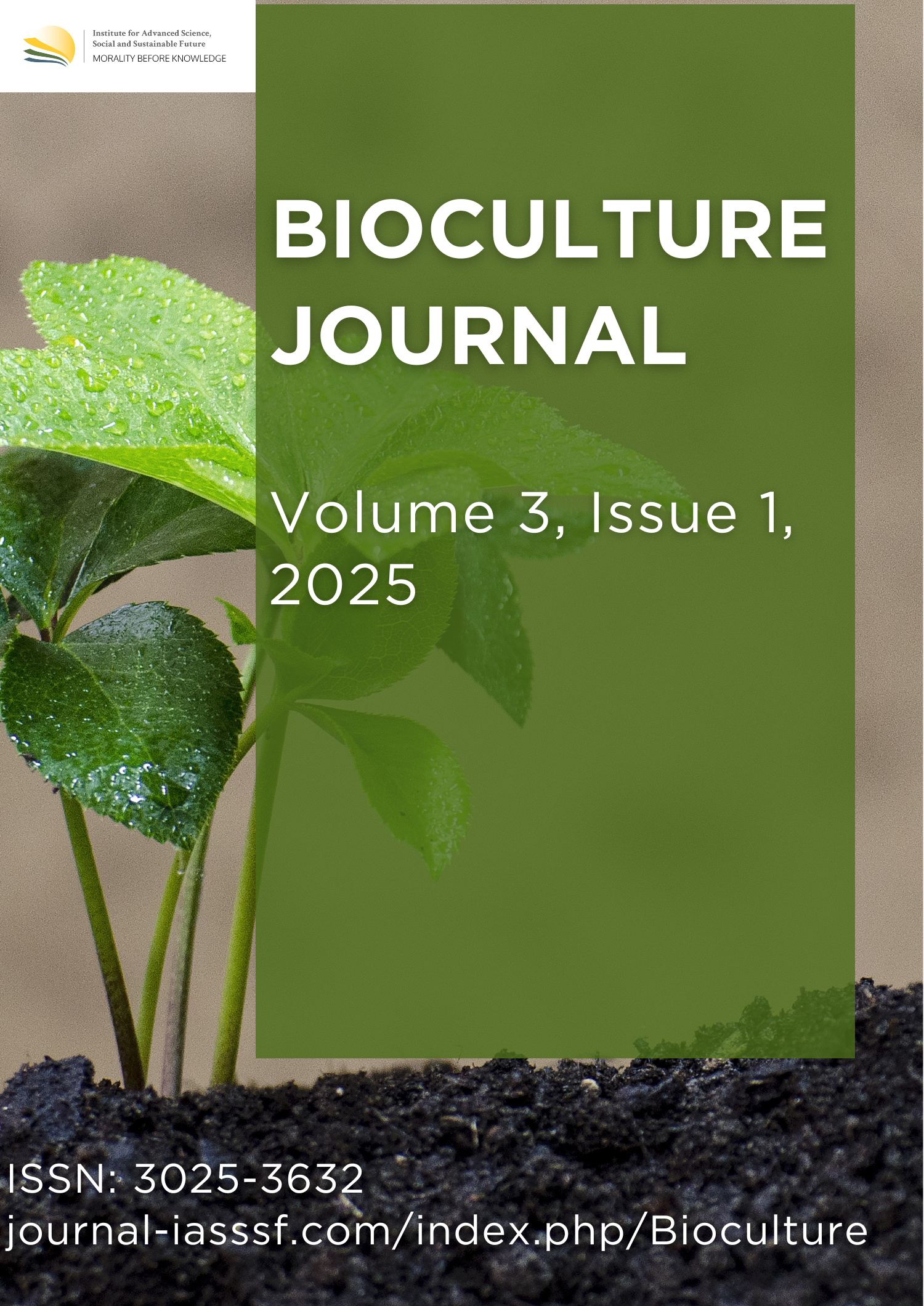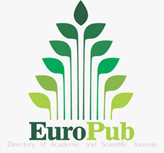Estimation of carbon stock in tea plants (Camellia sinensis) based on age variation at Tambi plantation unit
DOI:
https://doi.org/10.61511/bioculture.v3i1.2025.2285Keywords:
carbon stock, sentinel-2a imagery, tea plantAbstract
Background: As an effort to reduce current climate change, conservation measures such as carbon stock measurements are needed. Tea plants are a suitable commodity for transforming towards low carbon production because perennial plants such as can absorb and store more carbon than seasonal agricultural crops. Methods: Sampling was carried out using a random sampling method that was taken randomly to represent a population for each block number. Data collection for the study was carried out by taking 3 soil and plant samples at each age of the tea plant with an age of 10 years, 30 years, 40 years, and 100 years. The plant samples taken were leaves, stems, roots, and litter. The soil samples taken were soil with a depth of 0-10 cm, 10-20 cm, and 20-30 cm with disturbed and undisturbed soil sampling. Findings: The total carbon stock value of tea plants stored in the Pemandangan Block UP Tambi is 63.17 tons/ha in 10-year-old tea plants; 67.26 tons/ha in 30-year-old tea plants; 67.87 tons/ha in 40-year-old tea plants; and 69.40 tons/ha in 100-year-old tea plants. After analyzing the relationship between physical and chemical properties of soil with biomass carbon reserves, C-Organic, soil texture, and soil volume weight are the parameters that most influence carbon reserve content. Conclusion: Plant age due to replanting and pruning, making them unsuitable for soil carbon stock estimation. Novelty/Originality of this article: This study offers novelty by integrating field-based carbon stock measurements of tea plants with variations in plant age and Sentinel-2A remote sensing analysis, providing a unique contribution to understanding the relationship between soil properties, biomass, and carbon storage capacity in tea plantations, which has not been extensively explored in previous research.
References
Ajidirman. (2010). Kajian kandungan mineral alofan dan fenomena fiksasi fosfor pada andisols. Hidrolitan, 1(2), 15–20.
Akhbar, A., Muardimansyah, S., & Arianingsih, I. (2016). Cadangan karbon tanah pada berbagai tingkat kerapatan tajuk di Hutan Lindung Kebun Kopi Desa Nupabomba Kecamatan Tanantovea Kabupaten Donggala. Jurnal Warta Rimba, 4, 125–131. http://jurnal.untad.ac.id/jurnal/index.php/WartaRimba/article/view/7289/5876
BSN. (2011). Pengukuran dan penghitungan cadangan karbon – Pengukuran lapangan untuk penaksiran cadangan karbon hutan (Ground Based Forest Carbon Accounting). BSN.
Basuki, Zubaidah, S., & Husin. (2018). Evaluasi sifat kimia tanah menurut jarak dari sungai di daerah pasang surut Kecamatan Kota Besi, Kotawaringin Timur, Kalimantan Tengah. Jurnal Agri Peat, 19(1), 1–14. https://doi.org/10.36873/agp.v19i01.150
Budhisurya, E., Anggono, R. C. W., & Simanjuntak, B. H. (2013). Analisis kesuburan tanah dengan indikator mikroorganisme tanah pada berbagai sistem penggunaan lahan di Plateau Dieng. Agric, 25(1), 64–72. https://ejournal.uksw.edu/agric/article/view/152
Chen, J., Huang, H.-Z., Wang, J., Xiang, Y.-P., & Shen, L.-X. (2013). Study on carbon storage of traditional arbor tea ecosystem of the Bulang nationality in Jingmai Mountain. Journal of West China Forest Science, 76–80. https://www.cabidigitallibrary.org/doi/full/10.5555/20133195046
European Space Agency. (2015). Sentinel-2 user handbook (pp. 42–50). Paris. https://sentinels.copernicus.eu/documents/247904/685211/Sentinel-2_User_Handbook
Ferdeanty, F., Sufardi, S., & Arabia, T. (2019). Karakteristik morfologi dan klasifikasi tanah andisol di lahan kering Kabupaten Aceh Besar. Jurnal Ilmiah Mahasiswa Pertanian, 4(4), 666–676. https://doi.org/10.17969/jimfp.v4i4.12694
Fiantis, D., Hakim, N., & Van Ranst, E. (2005). Properties and utilisation of andisols in Indonesia. Tohoku University.
Gatti, A., & Bertolini, A. (2015). Sentinel-2 products specification document. https://sentinel.esa.int/documents/247904/685211/Sentinel-2-Product
Gebrehiwot, K., Desalegn, T., Woldu, Z., Demissew, S., & Teferi, E. (2018). Soil organic carbon stock in Abune Yosef afroalpine and sub-afroalpine vegetation, northern Ethiopia. Ecological Processes, 7(1), 1–9. https://doi.org/10.1186/s13717-018-0117-9
Heriyanto, T., Amin, B., Rahimah, I., & Ariani, F. (2020). Analisis biomassa dan cadangan karbon pada ekosistem mangrove di kawasan pantai berpasir Desa Kawal Kabupaten Bintan. Jurnal Maritim, 2(1), 31–41. http://dx.doi.org/10.51742/ojsm.v2i1.104
Kalita, R. M., Das, A. K., & Nath, A. J. (2017). Carbon stock and sequestration potential in biomass of tea agroforestry system in Barak Valley, Assam, North East India. International Journal of Ecology and Environmental Sciences, 42(5), 107–114. https://www.nieindia.org/Journal/index.php/ijees/article/view/1097
Mansyur, N. I., Antonius, A., & Titing, D. (2023). Karakteristik fisika tanah pada beberapa lahan budidaya tanaman hortikultura lahan marginal. Jurnal Ilmiah Respati, 14(2), 190–200. https://doi.org/10.52643/jir.v14i2.3779
Mardiana, G., Udiansyah, & Pitri, R. M. N. (2018). Potensi simpanan dan serapan karbon di atas permukaan tanah pada kawasan hutan Desa Sungai Bakar Kecamatan Bajuin. Jurnal Sylva Scienteae, 1(1), 23–29. https://ppjp.ulm.ac.id/journals/index.php/jss/article/view/455
Nwokocha, C. C., Akamigbo, F. O. R., & Chukwu, G. O. (2003). Characterization and evaluation of soils of Umuahia north local government area of Abia State, for agricultural production. In Ojeniyi et al. (Eds.), Land degradation, agricultural productivity and rural poverty: Environmental implications (Vol. 5, No. 7, pp. 308–315). Proceedings of the 28th Annual Conference of the SSSN.
Pang, J., Li, H., Tang, X., & Geng, J. (2019). Carbon dynamics and environmental controls of a hilly tea plantation in Southeast China. Ecology and Evolution, 9(17), 9723–9735. https://doi.org/10.1002/ece3.5504
Putri, A. H. M., & Wulandari, C. (2015). Potensi penyerapan karbon pada tegakan damar mata kucing (Shorea javanica) di Pekon Gunung Kemala Krui Lampung Barat. Sylva Lestari, 3(2), 13–20. https://doi.org/10.23960/jsl2313-20
Ramos, F. T., Dores, E. F. d. C., Weber, O. L. d. S., Beber, D. C., Campelo, J. H., Jr., & Maia, J. C. d. S. (2018). Soil organic matter doubles the cation exchange capacity of tropical soil under no-till farming in Brazil. Journal of the Science of Food and Agriculture, 98(9), 3595–3602. https://doi.org/10.1002/jsfa.8881
Ririska, R., Juniarti, J., & Darfis, I. (2023). Kajian beberapa sifat fisika dan kimia tanah pada lahan tanaman aren (Arenga pinnata Merr) berdasarkan kelerengan di Nagari Gadut Kecamatan Tilatang Kamang Kabupaten Agam. Journal of Top Agriculture, 1(1), 1–15. http://repo.unand.ac.id/id/eprint/50012/contents
Rusdiana, O., & Lubis, R. S. (2012). Pendugaan korelasi antara karakteristik tanah terhadap cadangan karbon (carbon stock) pada hutan sekunder. Journal of Tropical Silviculture, 3(1), 98–101. https://doi.org/10.29244/j-siltrop.3.1.%25p
Rusolono, T., Tiryana, T., & Purwanto, J. (2015). Panduan survei cadangan karbon dan keanekaragaman hayati di Sumatera Selatan. Biodiversity and Climate Change Project (BIOCLIME), German International Cooperation (GIZ).
Sahfitra, A. A. (2023). Variasi kapasitas tukar kation (KTK) dan kejenuhan basa (KB) pada tanah hemic haplosaprist yang dipengaruhi oleh pasang surut di Pelalawan Riau. Biofarm: Jurnal Ilmiah Pertanian, 19(1), 103–112.
Santi, I. N., Hayata, H., & Bangun, B. (2023). Characteristics of peat with different depths in supporting growth and productivity of oil palm. Journal of Tropical Soils, 28(1), 17–22. https://doi.org/10.5400/jts.2023.v28i1.17-22
Siringoringo, H. H. (2014). Peranan penting pengelolaan penyerapan karbon dalam tanah. Jurnal Analisis Kebijakan Kehutanan, 5(1), 23–25. https://doi.org/10.20886/jakk.2014.11.2.175-192
Sorbu, A. W., Cabuy, R. L., & Rumatora, A. (2021). Variasi nilai total estimasi biomasa dan nekromasa pada beberapa tipe hutan di Kabupaten Manokwari Provinsi Papua Barat. Jurnal Kehutanan Papuasia, 7(1), 68–79. https://jurnalpapuaasia.unipa.ac.id/jurnalpapuasia/article/download/239/196
Sukarman, & Dairiah, A. (2014). Tanah andosol di Indonesia: Karakteristik, potensi, kendala, dan pengelolaannya untuk pertanian. Balai Besar Penelitian dan Pengembangan Sumberdaya Lahan Pertanian.
Tisdale, S. L., Nelson, E. L., Beaton, J. D., & Havlin, J. L. (1999). Soil fertility and fertilizers: An introduction to nutrient management (6th ed.). Macmillan Publishing Company.
Uthbah, Z., Sudiana, E., & Yani, E. (2017). Analisis biomasa dan cadangan karbon pada berbagai umur tegakan damar (Agathis dammara (Lamb.) Rich.) di KPH Banyumas Timur. Scripta Biologica, 4(2), 119–124. https://doi.org/10.20884/1.sb.2017.4.2.404
Wada, K. (1989). Allophane and imogolite. In Minerals in soil environments (Vol. 1, pp. 1051–1087). https://doi.org/10.2136/sssabookser1.2ed.c21
Xia, Q., Rufty, T., & Shi, W. (2020). Soil microbial diversity and composition: Links to soil texture and associated properties. Soil Biology and Biochemistry, 149, 107953. https://doi.org/10.1016/j.soilbio.2020.107953
Yusra, Y., Khusrizal, K., & Hastriana, K. H. (2023). Variasi umur pamelo rakyat terhadap perubahan sifat fisik tanah di Kabupaten Bireuen Propinsi Aceh. Jurnal Agrium, 20(2), 140–149. https://doi.org/10.29103/agrium.v20i2.11445
Zurhalena, & Farni, Y. (2010). Distribusi pori dan permeabilitas ultisol pada beberapa umur pertanaman. Jurnal Hidrolitan, 1(1), 43–47. https://online-journal.unja.ac.id/hidrolitan/article/download/411/6945
Downloads
Published
How to Cite
Issue
Section
Citation Check
License
Copyright (c) 2025 Farras M Yusa

This work is licensed under a Creative Commons Attribution 4.0 International License.

















